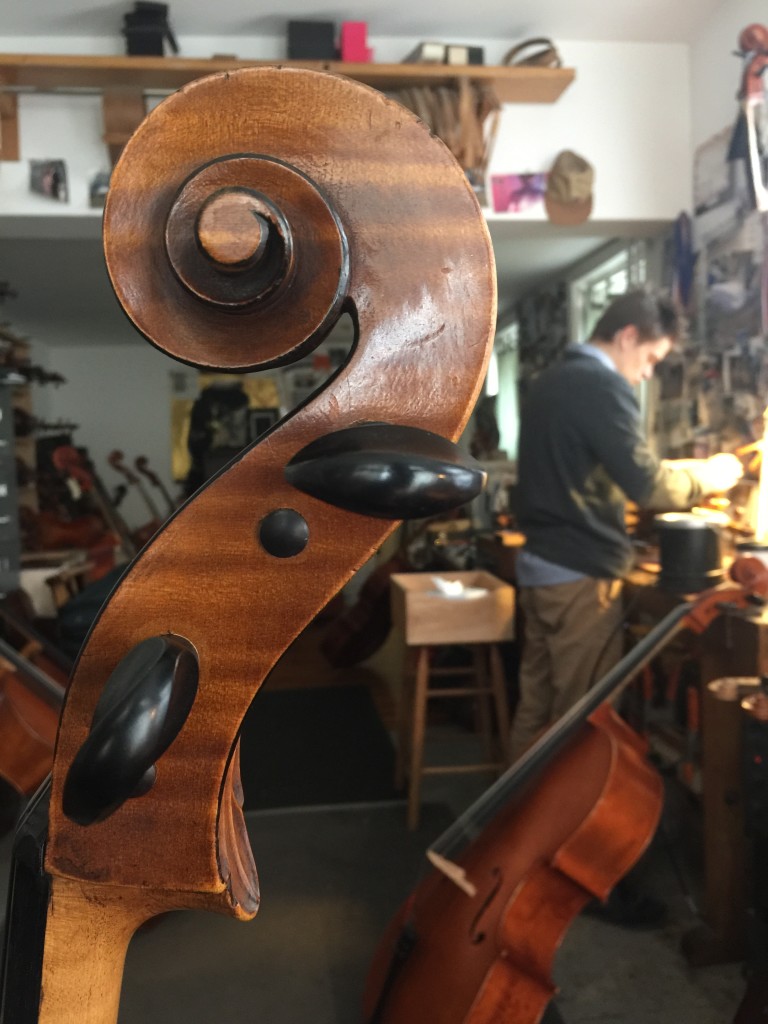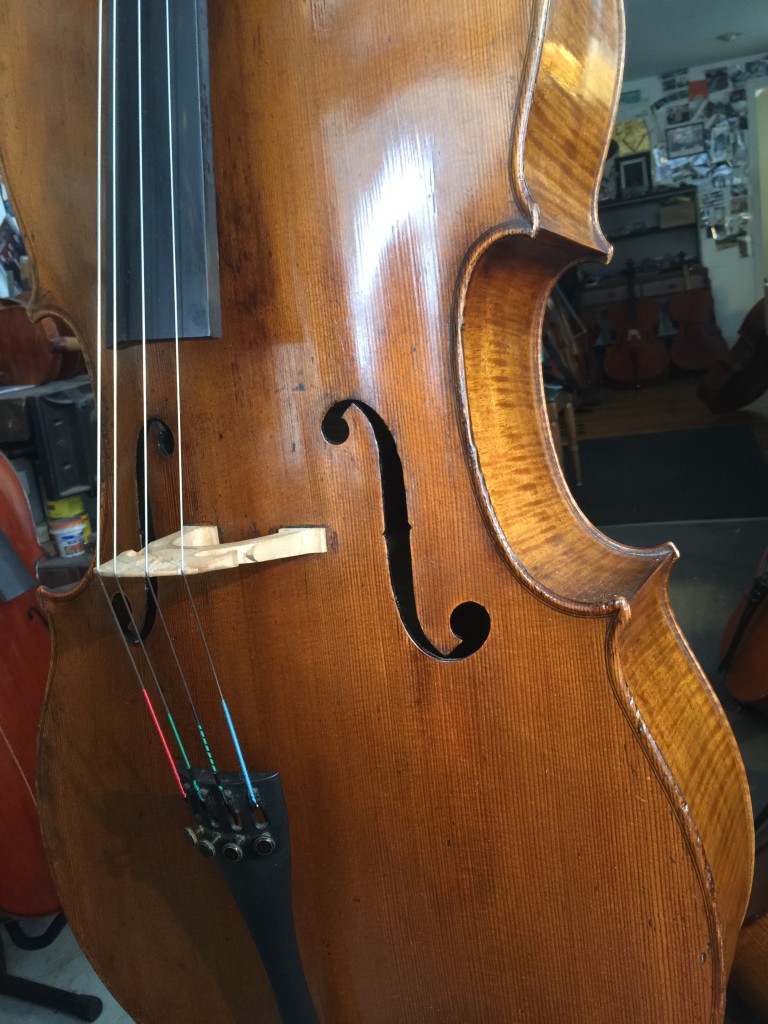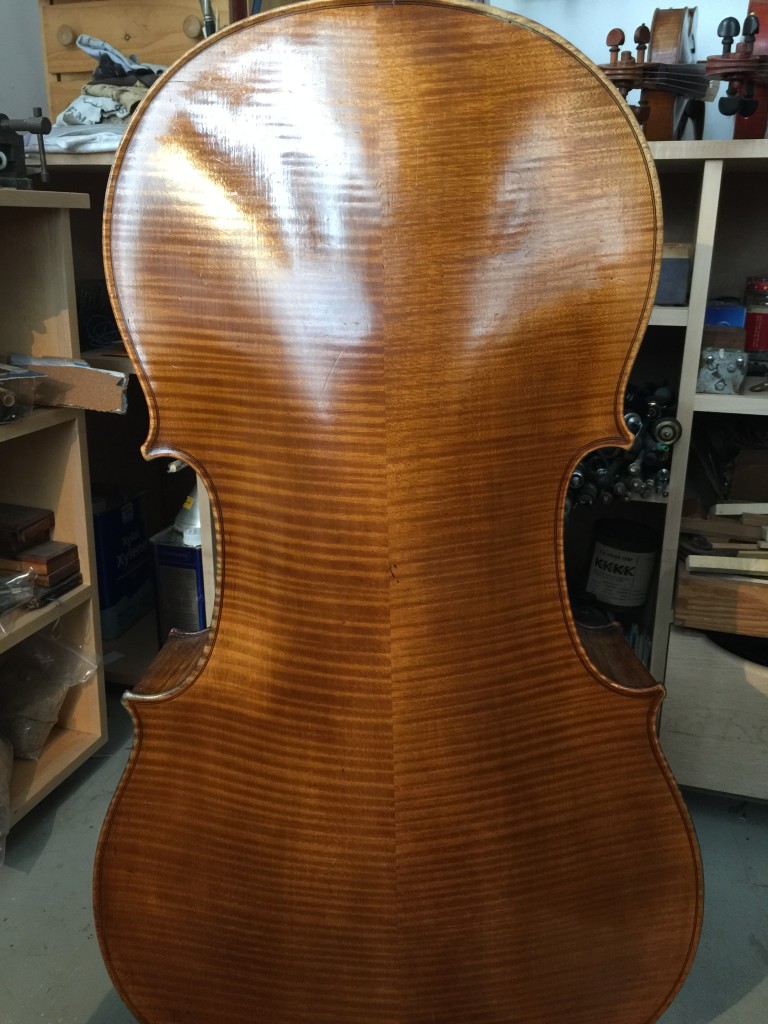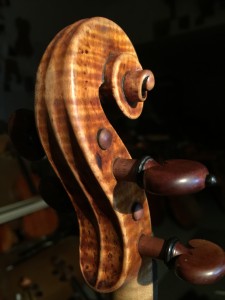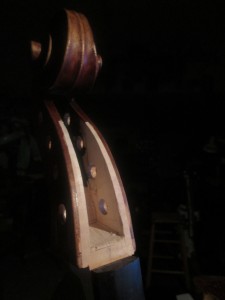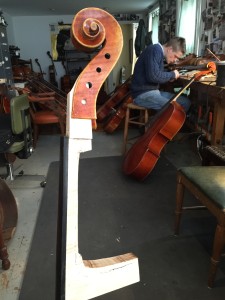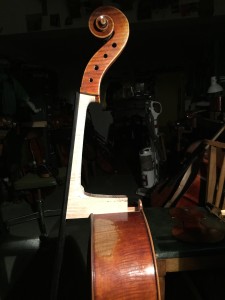Beautiful cello by Chas JB Collin-Mezin 1870’s cello that is offered for sale. One of the finest French luthiers of the late 19th /early 20th century….he blends supreme control and exactitude with the warmth and patina of the old world…. truly a special cello to consider
5 string conversion
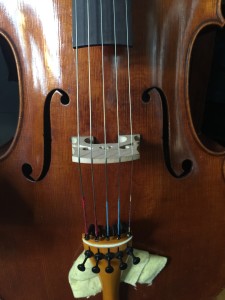 Fun project converting an older German cello that belongs to Derek Barnes of the Philadelphia Orchestra into a 5 string cello …. with a high E. I removed the old fingerboard and replaced it with a wider one that flared subtly outward from the neck to allow as much playing surface to space the strings…. along with a new top nut. Here is a shot of the Baroque bridge being roughed out… and me tentatively working out the overall and individual spacing for playability. Derek had a clever idea of drilling an extra hole in the A peg to accept the E string. By adjusting the amount of tail of the E string pulling through the peg you could tune both strings quite close to pitch and then use fine tuners from there…. much easier than bushing all 4 peg holes and reaming out 5 new ones!
Fun project converting an older German cello that belongs to Derek Barnes of the Philadelphia Orchestra into a 5 string cello …. with a high E. I removed the old fingerboard and replaced it with a wider one that flared subtly outward from the neck to allow as much playing surface to space the strings…. along with a new top nut. Here is a shot of the Baroque bridge being roughed out… and me tentatively working out the overall and individual spacing for playability. Derek had a clever idea of drilling an extra hole in the A peg to accept the E string. By adjusting the amount of tail of the E string pulling through the peg you could tune both strings quite close to pitch and then use fine tuners from there…. much easier than bushing all 4 peg holes and reaming out 5 new ones!
Fascinating to hear the whole other world a cello can produce when the sound leaves the A string and soars into the unknown reaches of the E string!
David Bromberg’s collection
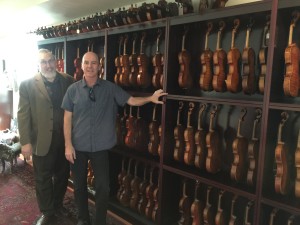 Always enjoyable to meet with David …we’ve collaborated on some restoration projects over the years…. and here we are standing with his impressive collection of American violins. His collection is going to be part of the Library of Congress and he has asked me to set up/adjust and make them all they can be as they enter this prestigious institution. It will be fascinating to get to know all these instruments ….and I’ve found that the best way to do this is through the time spent working on them…. and there should be plenty of that.
Always enjoyable to meet with David …we’ve collaborated on some restoration projects over the years…. and here we are standing with his impressive collection of American violins. His collection is going to be part of the Library of Congress and he has asked me to set up/adjust and make them all they can be as they enter this prestigious institution. It will be fascinating to get to know all these instruments ….and I’ve found that the best way to do this is through the time spent working on them…. and there should be plenty of that.
Dramatic cello back
This dramatic cello is a mid 19th century Italian instrument by Andrea Postachinni… and is part of the gorgeous sound that is the Philadelphia Orchestra.It is always inspiring to work on such a bold, artistic instrument. It does make me smile though, thinking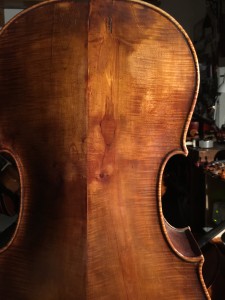 of what reaction I might get if I made an instrument with wood such as this and submitted it to a competition….. I have a distinct feeling that I would be ridiculed…. which is a shame in that we are missing some of the essence of the great string instruments of Italy. The sense of daring … the personality … the sense of making a magical,musical instrument….not with sterile competence …but as if its a matter of life and death ….thats what I think is the most moving aspect of Italian instrument making….
of what reaction I might get if I made an instrument with wood such as this and submitted it to a competition….. I have a distinct feeling that I would be ridiculed…. which is a shame in that we are missing some of the essence of the great string instruments of Italy. The sense of daring … the personality … the sense of making a magical,musical instrument….not with sterile competence …but as if its a matter of life and death ….thats what I think is the most moving aspect of Italian instrument making….
Another interesting quirk of this instrument and its maker is the center seam area… you can see from the shadow that the center seam comes up to a rather hard ridge line , rather than the usual rounded arching ( I’ve also seen this on his violins)…I’m not sure if he does this for acoustical reasons ( like added mass changing the tone/sound) or maybe he does it to add more gluing surface to the center seam ( for strength/durability)….or maybe he was just trained this way….another instance of individual personality that fascinates the discriminating admirer….
Dramatic fall leads to a painstaking repair
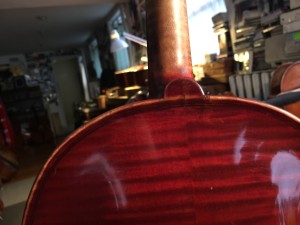
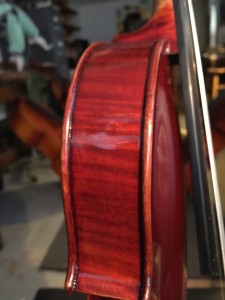
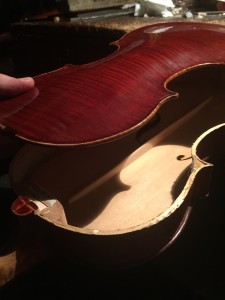
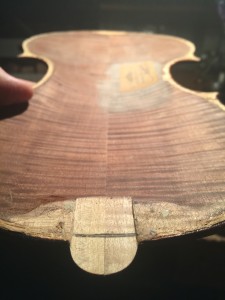
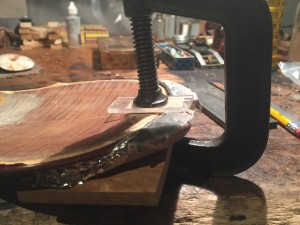
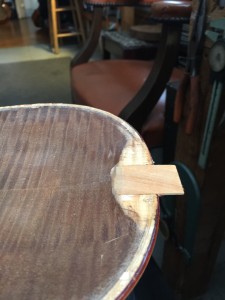
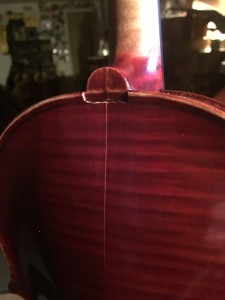 This nice Italian violin from the 1940’s hit the floor from shoulder height….causing the neck to erupt at the button are and the center seam of the back to open up. (There were also cracks on the top and ribs which I restored but won’t be part of this post)
This nice Italian violin from the 1940’s hit the floor from shoulder height….causing the neck to erupt at the button are and the center seam of the back to open up. (There were also cracks on the top and ribs which I restored but won’t be part of this post)
The button is a very delicate spot….at once, stressed by the string tension pull on the neck and compromised by the purfling channel which cuts through almost half the thickness at that area. It looked like this violin hah been repaired here in the past … but not patched to span the weak area of the purfling channel cut. So its no wonder that it erupted….
The first step is to carefully remove the back and free the damaged button from the top block.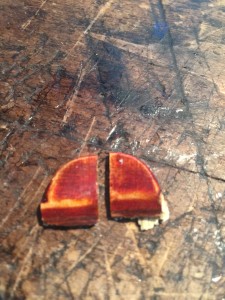 Once the button is carefully re-assembled and precisely glued back t the back a cast is made of the upper back to aid in the delicate cutting of a channel to fit the patch and eventually glue it in without distorting things.
Once the button is carefully re-assembled and precisely glued back t the back a cast is made of the upper back to aid in the delicate cutting of a channel to fit the patch and eventually glue it in without distorting things.
Once the maple patch is fit and glued in the channel ( which has been worked down gently to 2 mm thick) it is planed flush with the platform that will be glued to the top block.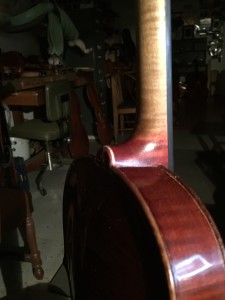
Once the back is re-glued to the ribs and the neck reset …. the only evidence of the accident is the the sliver of the patch existing as a layer between the button and the neck stock…. until with patient varnish restoration everything disappears…the only slight reservation in this instance are the lines on each side of the button repair that are from the previous repair that can’t be removed …. also on the side photo of the upper rib ….there is a 2″ crack in the mid part between neck and the rib miter …coming up diagonally from the back ….see if you can see it
Mr Moennig was quite a master of varnish touch up and restoration …and working with him has had a life long effect. You learned by doing the wood work and handing it to him to restore the varnish ( all the while carefully examining my work!). Eventually you were able to do the whole repair and then hand to him to cast his eye over it….an eye that was very at home with looking at the finest instruments and the finest restoration….just the eye you want looking at your work
Pristine Vuilluame viola
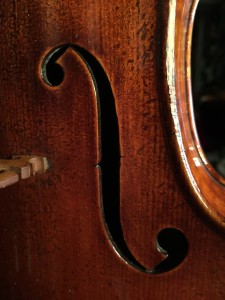
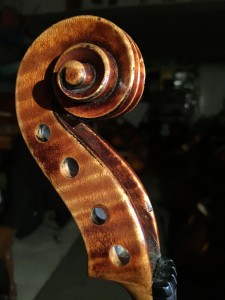
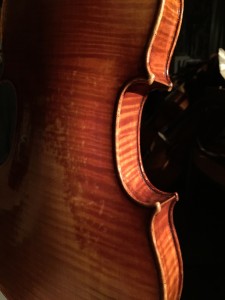
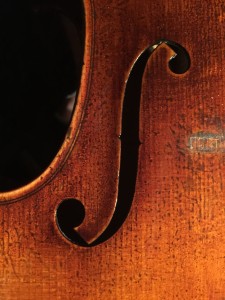 This dramatically beautiful viola is by the great J B Vuilluame made in Paris in 1847 and is opus #1773. It bears the handwritten number 47 on the interior ( the upper back) surrounded by an ornament. It is a Strad inspired instrument that is a quite rare example both because of its perfect condition … but also its small size at 396 mm ( just over 15 1/2″).
This dramatically beautiful viola is by the great J B Vuilluame made in Paris in 1847 and is opus #1773. It bears the handwritten number 47 on the interior ( the upper back) surrounded by an ornament. It is a Strad inspired instrument that is a quite rare example both because of its perfect condition … but also its small size at 396 mm ( just over 15 1/2″).
It is owned and played by a man who studied with the great William Primrose as a young, ambitious player. He eventually dedicated himself to becoming a world class chemist… but still plays this inspiring instrument daily….at an unimaginably early hour for a nightowl like me!
Vuilluame is clearly the greatest maker of the 19th century outside of Italy. He has the most intimate knowledge and collection of instruments of the great masters of Cremona….and he puts it to great use. This lovely viola captures Strad’s powerful, ruggedly beautiful turns of the scroll….and the delicate grace of the F hole. The viola bears an original “wear” pattern on the back … beautifully executed by someone who has seen the natural effects of time and use on instruments that are played as well as cherished.
Everything about this fine instrument and player speaks of deep time….he has owned /played/cherished it for 50 years…and I see it yearly to keep it at its finest…. in addition to all the things I will (carefully!) do ….this year I will cut a new bridge for it…. the last one lasted 50 years! …. so I am thinking thoughts about deep time while I cut this bridge…..
Exquisite Amati scroll
Cello neck graft
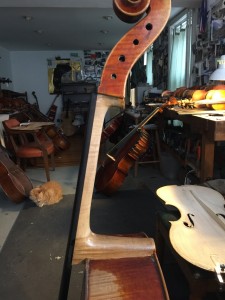 A talented player who studies with Jeff Solow at Temple had an accident with a cello that she had purchased from me a number of years ago. When the cello hit the ground the scroll sheared off
A talented player who studies with Jeff Solow at Temple had an accident with a cello that she had purchased from me a number of years ago. When the cello hit the ground the scroll sheared off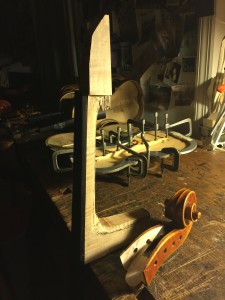 …and the long ordeal of the cello neck graft was on. The first step is to remove the scroll from the neck and prepare it to accept the graft. The peg box is carved out at flat angles that will provide the maximum gluing surface to ensure a lasting bond. Next step is to fashion the graft out of similar flamed maple as the cello. Using templates the neck is band sawed roughly then cleaned up by hand … with the upper part a series of angles corresponding to the prepared scroll. The scroll is then fit downward with some tension and the graft is carefully worked to let the scroll continue downward until its completely fits ( using a chalk transfer)on all surfaces at the desired spot right at the top edge of the fingerboard.
…and the long ordeal of the cello neck graft was on. The first step is to remove the scroll from the neck and prepare it to accept the graft. The peg box is carved out at flat angles that will provide the maximum gluing surface to ensure a lasting bond. Next step is to fashion the graft out of similar flamed maple as the cello. Using templates the neck is band sawed roughly then cleaned up by hand … with the upper part a series of angles corresponding to the prepared scroll. The scroll is then fit downward with some tension and the graft is carefully worked to let the scroll continue downward until its completely fits ( using a chalk transfer)on all surfaces at the desired spot right at the top edge of the fingerboard.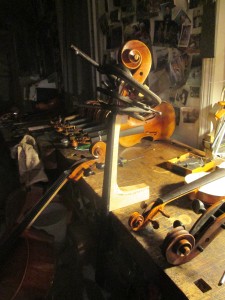 Once glued the pegbox is carved out and the neck is roughly shaped and made ready to set into the corpus of the instrument.
Once glued the pegbox is carved out and the neck is roughly shaped and made ready to set into the corpus of the instrument.
Making a cello Curtis worthy
Andres Sanchez came to me about a year ago as he was readying himself to audition for Curtis. He wanted his cello to sound as good as possible…a big,round sound…..bold/warm/rich….i.e. what every cellist wants…it all! It is a nice cello….but wasn’t particularly distinguished…I took the cello apart …changing the bass bar / raising the neck angle / new bridge & post…and anything else I could do to get the most and best out of his cello.
Well he was accepted to Curtis….and I certainly don’t want to say that his cellos sound had too much effect on that decision ….but the point I would like to stress is that many instruments are sounding 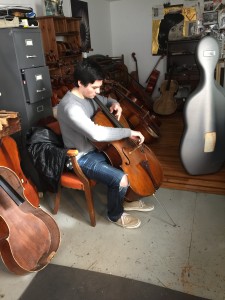 OK ….but with the right drive and a little sense of daring …..things could be happening on a whole other level. It seems to me that life is way to short and players work way too hard to not be getting all the magic they can out of their instrument.
OK ….but with the right drive and a little sense of daring …..things could be happening on a whole other level. It seems to me that life is way to short and players work way too hard to not be getting all the magic they can out of their instrument.
In this visit he brought me the cello with the usual lower bridge due to winter weather… along with the wear and tear of a worn,rutted fingerboard due to countless hours of practice and open seams due to dry winter weather, touch up etc. ( with photos of the bridge in progress.
Andres also mentioned the idea of making the new bridge on the high side to get even more power ….( I’ve never met a serious cellist that thought more power wasn’t a great idea!). By cutting the bridge high you get more tension down on the top and hence more power – (along with a little more effort needed to play)…and of course the reaction was WOW!…..I think that one word sums up mission statement. I also appreciate his determination to pursue better and the willingness to take a chance – which is the soul of the artistic life.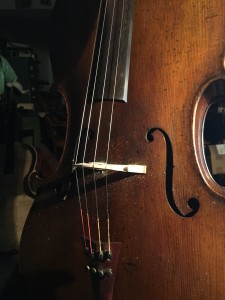
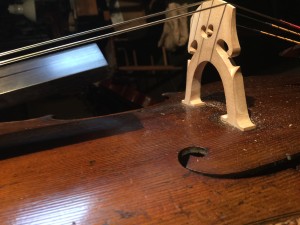
Beautiful JB Vuilluame f hole
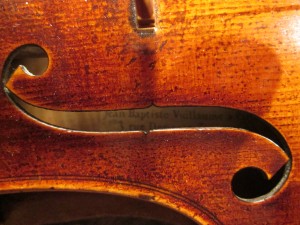 It is remarkable that Vuilluame’s instruments attain such a consistently high level given the number of different skilled hands are at work in his shop. The attention to detail in his work is both subtly exact and thoroughly artistic. This photo of the delicate bass f hole of a viola that passed through my hands shows this admirably. The way it flairs from the 2 soundholes and hits its widest at the notches before perfectly tapering toward the other soundhole is done with total command. I also love the sculptural fluting of the outer edge of the f hole (lower,bottom edge in photo) Notice that the top flairs up from the purfling to the edge of the f hole to highlight the living,organic shape of the arching. Also to be enjoyed is a small taste of his handsome varnish….
It is remarkable that Vuilluame’s instruments attain such a consistently high level given the number of different skilled hands are at work in his shop. The attention to detail in his work is both subtly exact and thoroughly artistic. This photo of the delicate bass f hole of a viola that passed through my hands shows this admirably. The way it flairs from the 2 soundholes and hits its widest at the notches before perfectly tapering toward the other soundhole is done with total command. I also love the sculptural fluting of the outer edge of the f hole (lower,bottom edge in photo) Notice that the top flairs up from the purfling to the edge of the f hole to highlight the living,organic shape of the arching. Also to be enjoyed is a small taste of his handsome varnish….
